
Population 76,136 (1901); 176,666 (1941)
Barwani was a Princely state in the Malwa agency (present day Madhya Pradesh) in the center of India on the left bank of the Narmada River. Ruler Maharana Sir Ranjit Singhji II Bahadur (1894-1930) issued the first stamps, perhaps as late as 1921.
The stamps were type set in blocks of 4 in booklets containing 32 examples of one value. They were issued without gum, on wove paper perforated 7, on 2 or 3 or 4 sides or imperforate on laid paper.
Click here to see all stamps from Barwani in this exhibition.
The dynasty of Barwani was founded in the early-to-mid middle ages, and there have been over 50 chiefs. As a small state, Barwani has been subject to the will of larger forces. At times, its Rajput Hindu Ranas were forced to accept the Islamic faith.
The original capital was moved, in about 1650, from Avasgarh to Barwani. Subsequently, the Maratha empire robbed Barwani of much territory, but it was not forced to pay tribute. Treaties with the British East India Company were signed by Rana Mohad Singh II sometime after 1794. Several unsuccessful or minority Ranas followed.
The treaty with the British give some insight into the terms by which princely states existed. The Rana had civil and revenue control, but punishment for serious crimes had to be submitted to British authority. Sales of opium and liquor were in the hands of the Rana, the rights to the latter of which was purchased by tribal headmen. State schools opened under the Raj, but the literacy rate remained extremely low. In 1909, the town of Barwani contained a British post office, a telegraph, a hospital, and a jail. The state paid no tribute to, nor received any revenues from, the British. Barwani actively supported the British in both world wars.
In the first decade of the twentieth century, Hindus were listed at about half of the population, the tribe of Bhil as over forty percent, and the remainder Muslim. (However, it was speculated that many tribal Bhils identified, wrongly, as Hindus.) Almost 70% of the population spoke Bhil.
The British was reported that almost all inhabitants of the countryside belonged to jungle tribes. The state was described as “picturesque,” with hilly ranges and valleys covered with thick forest. Many ruined and overgrown forts and mosques attested to former prosperity and past Muslim influence. The area specialized in cattle breeding, but much fertile land was not under cultivation.
There was only one town, and 333 villages. Barwani city was – and is – a pilgrimage destination for Jains, because of a huge holy statue of an early teacher, with dates carved in stone dating from 1166.
The Rana acceded to India in 1948. The state, and city remain accessible only by road, with no rail line. The population is largely illiterate, and dependent on agriculture.
In 2003, over 50% of the population lived below the poverty line.
Barwani has again become a district in India and contains over a million people. The current ruler, though only titular, is the 58th of the line.
Barwani
1921
1/4 Anna Dull Prussian Green
1/2 Anna Dull Blue
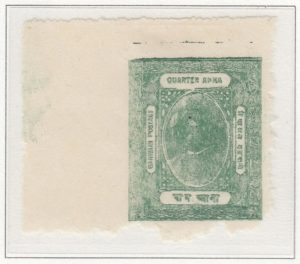
Blurred Impressions
Medium Wove Paper
Perforated 7 On Two Or Three Sides
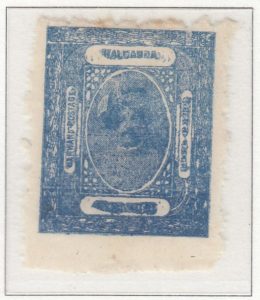
Blurred Impressions
Medium Wove Paper
Perforated 7 On Two Or Three Sides
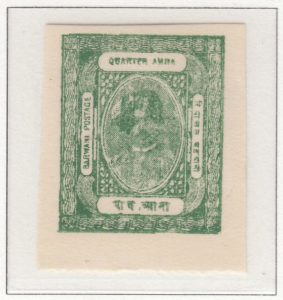
Clear Impressions
Vertically Laid Batonne Paper
Perforated 7 In Two Or Three Sides
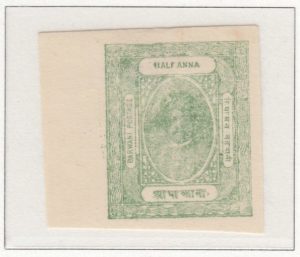
Clear Impressions
Vertically Laid Batonne Paper
Perforated 7 In Two Or Three Sides
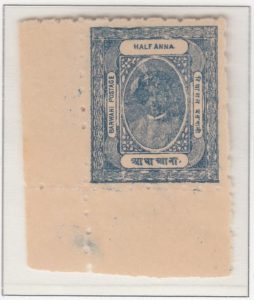
A very nicely designed and researched site.
I recently discovered this site while searching how to identify feudal stamps of India. I am reading the history of each going down the list of the states and have found the information and pictures of stamps very helpful nd fascinating.
Thank you.
Daljit Kohli
Beautiful and valuable site!
However, the dates and issues illustrated for Barwani are incorrect, the first issue was 15 May 1917 of earlier shades of the same two values. See the current SG catalogue and articles in India Post by Dan Walker.